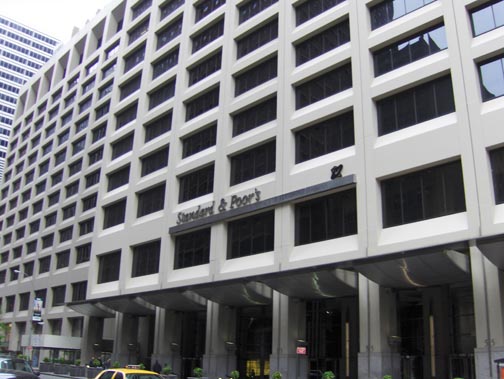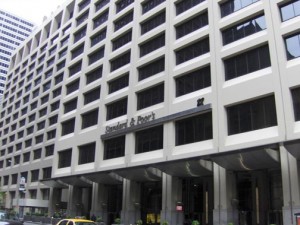S&P: 1-in-3 chance of a Puerto Rico ratings cut by ’15


In October, S&P’s Ratings Services affirmed its ‘BBB-‘ rating, which reflected Puerto Rico’s long history of structural deficits, an ongoing need for external financing and a protracted economic contraction.(Credit: Wikipedia)
Puerto Rico’s general obligation credit ratings could be spared from another downgrade from Standard & Poor’s at least through March 2015 if the government makes good on its commitment to rein in its structural deficit over the next two years, follows through on its plans to reduce major liabilities, such as public pensions, and upholds its revenue stream.
However, if conditions are not met, there is a greater than 1-in-3 chance S&P could lower the rating on the commonwealth within its two-year outlook horizon that began in March 2013, when it downgraded Puerto Rico’s rating to near-junk status at ‘BBB-‘ with a negative outlook on the GO bonds and appropriation-backed debt.
David Hitchcock, Standard & Poor’s credit analyst and senior director shared the agency’s views on Puerto Rico’s credit standing and outlook during a webcast Tuesday, when he broke down the reasons why the island’s credit remains at investment grade and the reasons why that could change.
“We feel the current administration has enacted significant corporate tax increases, including reinstatement of 2010 corporate tax rates, an adjustment to the corporate alternative minimum tax, a gross receipts tax, and other measures to rein in a very large deficit that occurred in fiscal 2013,” he said.
“We calculate that, if budget targets are met, the Puerto Rico general fund would need to fund about 8 percent of its budget in fiscal 2014 with some form of deficit financing, a reduction from a 22 percent structural deficit of ongoing revenues minus ongoing expenditures that occurred in fiscal 2013 based on the most recent information we have received,” he said.
Puerto Rico has announced an intention to float its general fund debt financing needs for fiscal 2014 through the Puerto Rico Sales Tax Financing Corp. (known as COFINA by its initials in Spanish). Gov. Alejandro García-Padilla’s administration has vowed to lower next year’s deficit and have no structural deficit by 2016.
“We have heard from previous administrations indications of intent that they would have a structural balance, but there have been real efforts so far,” Hitchcock said. “The current budget has a payment for the Teacher’s Pension reform, which has not been enacted, but has been proposed, and we feel it’s likely to occur. Although the funded ratio/unfunded liabilities are still very poor, this addresses it and helps cap the amount of payments in the future.”
In October, S&P’s Ratings Services affirmed its ‘BBB-‘ rating, which reflected Puerto Rico’s long history of structural deficits, an ongoing need for external financing and a protracted economic contraction that will now seemingly extend well into next year, according to recent Planning Board revisions.
Liquidity not immediate concern
Aside from the deficit considerations and the soured economy, S&P is also looking at the government’s liquidity, which he said, “is not an immediate concern for Puerto Rico.”
Puerto Rico has arranged about $1.2 billion of private cash flow notes and credit lines for fiscal 2014, a small portion of which has already been repaid. Cash flow projections provided by the commonwealth show what we believe is adequate ending monthly cash flow through the end of fiscal 2014 without any further note sales. Through September, cash receipts appear to be running slightly ahead of original projections, S&P noted.
Another reason why Puerto Rico’s credit remains at investment grade has to do with the “politically painful” decisions the administration has made to raise water, sewer, and electricity rates, as well as highway tolls and gas taxes, he said.
The latter two impositions are designed to make the Puerto Rico Highway Authority self-supporting in terms of debt issuance and eliminate General Fund subsidies earmarked for the agency.
“We do think this is a demonstrated indication of willingness to pay and work out some of the problems,” Hitchcock said.
He also noted as positive the fact that revenue collections are slightly above what were initially projected, but said it is a little too early to tell whether that increase is just about new revenue being phased in or whether ongoing revenues are higher.
What could lead to credit cut?
During the webcast, Hitchcock noted that a potential reason to lower the rating could be if Puerto Rico were to have a deficit above 8 percent in fiscal 2014.
“Even if they have an 8 percent deficit in Fiscal ’14 and they actually match their budget, we would still likely have negative outlook pending,” he said. “If they don’t have significant further deficit reduction in Fiscal ’15, or we view it unlikely when we get into March 2015 that a structural balance will occur in Fiscal ’16, we could lower the rating at that time.”
Finally, he said that if the island’s economic contraction is so large that closing the deficit is just not viable, “no matter what is done, that could force us to take ratings action at that point.”












